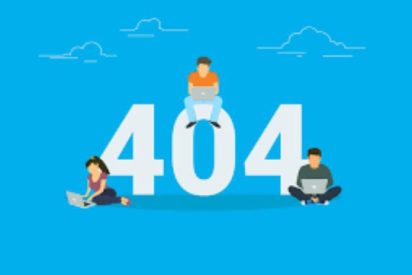Error 404: When It Occurs
Technically this error is obtained when the resource the user requests is not on your site.
Your site’s web server can’t retrieve that content because it no longer exists. Nothing serious. This is a normal and frequent situation in the “life” of a site. You may have eliminated a page because it is no longer needed, or you may have stopped selling a product because it is out of stock. You may have restyled the site and created some pages with different addresses than the previous version.
However, traces of old addresses remain on the web, and when someone intercepts these old links, the web server on which your site is hosted cannot satisfy the user’s request because the page no longer exists. The server then returns an error message through the 404 code.
Other causes that generate this type of error may not depend on you. For example, in the case of a person typing the URL of the page incorrectly or the occurrence of technical problems with the server (DNS, caching), usually, the root cause is the removal or movement of the content.
Also Read: How To Increase Instagram Story Views In 2024?
Other HTTP Error Codes
Technically, the web server returns a code, called a status code, each time a resource is called. The main status codes are:
- 200: The requested resource is available. It should be the most frequent situation.
- 301: The resource has been permanently redirected to another address.
- 302: The resource was temporarily redirected to another address. For example: when a product is out of stock, but only for a short time.
- 404: The resource is not present on the server.
- 500: generic server error message. It occurs in cases where there are technical problems with the machine.
- 503: server under maintenance.
The presence of status codes other than 200 can be a problem from an SEO point of view because, if they become numerous, they need to be clarified for the search engine crawler, i.e., the software that browses the web pages of your site.
Soft 404
There is also another type of 404 error called a Soft 404. This code is not an “official” status code of a web server but a code introduced by Google to indicate a page that, while returning a 200 code, is not consistent with the request made by the user. What does it mean that the site’s response could be more consistent? It means that the page obtained by the user is irrelevant to the search made. The site returns a page of little value to the user, for example, an incomplete page with very little content (this page ) or a generic page such as the home page. You can consult the Complete Guide to Soft 404 errors on the Search Engine Journal site to learn more.
Also Read: How To Use Emojis For Instagram Notes Ideas In 2024?
Why Fix The Causes Of 404 Errors
There are 2 reasons you should bother checking if your site is throwing 404 errors.
- User Experience: the visitor to your site’s expected content. Instead, he is catapulted to an error page.
- Loss of positions on search engines: a high number of pages with problems negatively impacts your site’s SEO.
Instead, eliminating Soft 404 errors is important to avoid hindering the work of the search engine crawler. The resource exists in case of these errors, but the bot will save time crawling and indexing it, wasting its crawl budget.
How To Locate The 404 Error
The easiest way to locate the list of 404 pages is to access the Google Search Console tool and click on Indexing > Pages (left column). By clicking on the “not found (404)” item in the table, you will get the list of resources that cause the error and will have to go and fix it. An alternative method is to go to Google Analytics or, for the more technical, directly to the log of the web server where the site is hosted or to install the Screaming Frog SEO Spider software.
Remember that you don’t have to fix all 404 errors, especially if you have many. Start by sorting out the ones that bring visits to your site. Search Console helps you locate them. You can also leave out 404 errors on pages that have no traffic. Google itself says so.
How To Fix The 404 Error
There are several ways to fix errors caused by pages that no longer exist on your site. The first way is to create a ” redirect, “i.e., an automatic redirection from the old page address that no longer exists to that of the new content. This is a very simple technical operation. If you have a WordPress site, specific plugins allow you to do this.
However, if you accumulate a lot of redirects over time, Google will start to be unhappy. For this reason, a more definitive way to intervene is to go and find which resources contain the link to the page that no longer exists.
Also Read: Find And Fix 404 Pages


